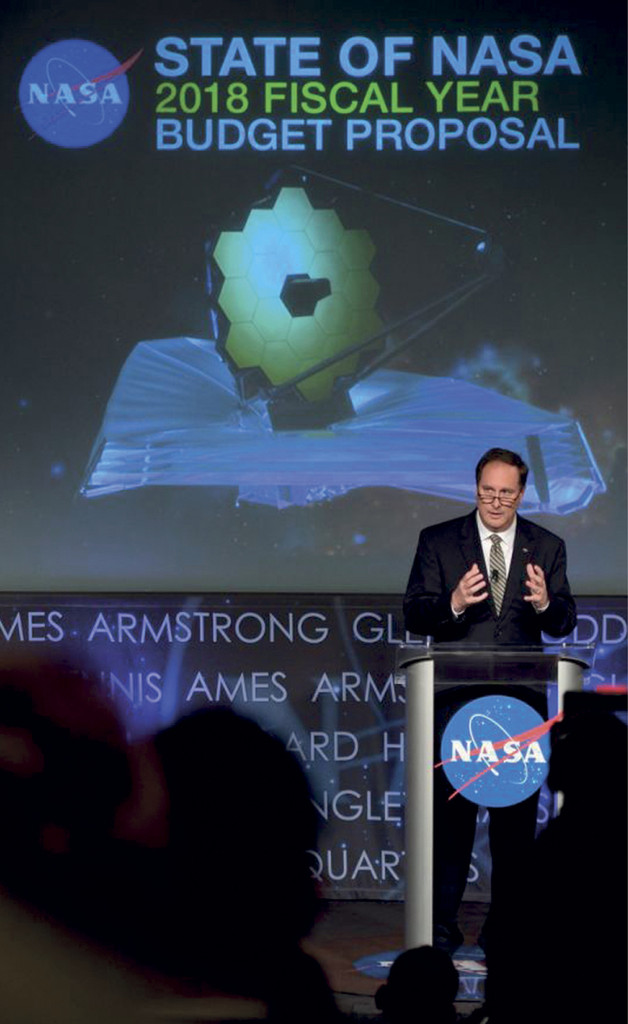 Close to completing its first year, the administration of US President Donald Trump has still been unable to approve the budget for the fiscal year that began October 1, 2017. The delay continues because Trump’s budget proposal sent to the legislature in February remains under discussion in Congress. A sign of progress was seen on October 19, when the Senate approved a US$4 trillion budget bill. Now under review in the House of Representatives, the plan maintains the levels of the previous year, although it increases funding for the defense sector. In the case of spending on research and development (R&D), Trump’s budget proposes a cut of approximately 5% in relation to the previous budget. Congress, however, has already signaled that it will not accept such a reduction. In October, the House of Representatives had proposed an R&D budget of US$164 billion—about US$15 billion higher than Trump’s proposal and US$12 billion more than the amount budgeted in 2016.
Close to completing its first year, the administration of US President Donald Trump has still been unable to approve the budget for the fiscal year that began October 1, 2017. The delay continues because Trump’s budget proposal sent to the legislature in February remains under discussion in Congress. A sign of progress was seen on October 19, when the Senate approved a US$4 trillion budget bill. Now under review in the House of Representatives, the plan maintains the levels of the previous year, although it increases funding for the defense sector. In the case of spending on research and development (R&D), Trump’s budget proposes a cut of approximately 5% in relation to the previous budget. Congress, however, has already signaled that it will not accept such a reduction. In October, the House of Representatives had proposed an R&D budget of US$164 billion—about US$15 billion higher than Trump’s proposal and US$12 billion more than the amount budgeted in 2016.
Matthew Hourihan, director of the Research and Development Budget and Policy Program at the American Association for the Advancement of Science (AAAS), explains that the distribution of research resources in the United States includes one important characteristic: “Public investments in science and technology are conducted by analyzing each department, such as defense, energy, and health, and the breakdown of the research budget is negotiated in appropriation committees in Congress,” he says. This characteristic is a factor in how the process of determining the US budget restricts the discretionary power of the executive branch, notes Fernanda De Negri, an economist at the Institute for Applied Economic Research (IPEA), who is currently a postdoctoral fellow at the Massachusetts Institute of Technology (MIT). “Congress plays a central role in the allocation of federal resources,” observes De Negri, author of a study on the science budget in the United States.
With this dynamic, federal agencies’ budgets can be discussed separately within the congressional committees. “The negotiations allow, for example, the director of the Defense Advanced Research Projects Agency [DARPA] to go to Congress and defend his budget. This openness helps the House of Representatives and the Senate to get a more realistic view of the demands of federal agencies,” she says. This model is different from the one adopted in Brazil, where the budget is authoritative, the researcher observes. “The Brazilian Congress authorizes a ceiling for what the government can spend. But determinations related to spending restrictions, payment limits, and division of resources is restricted to an internal discussion within the executive branch.”
Budget increases for only a few
According to Matthew Hourihan only a few major US agencies, such as the National Institutes of Health (NIH) and NASA are expected to see any increase in funding this fiscal year. “The budgets for most other science agencies and programs will be maintained or decreased somewhat,” he warns. He notes that recognition by congressmen and the general populace which was earned over decades by institutions like the NIH and NASA has been instrumental in preventing them from being subject to budget constraints. “Health research has always had a social impact, and NASA is an agency that lives in the voters’ imaginations, serving as a source of national prestige.” The impasses usually arise, says Hourihan, when determining funding within the scope of the applications of science. For example, research programs in the energy technology sector are sometimes accused by lawmakers of underutilizing private investment. And environmental research programs conducted by the Environmental Protection Agency (EPA) face growing resistance in the Trump government, which usually minimizes the impact of climate change.
In the case of the NIH, a Senate subcommittee has already approved an increase of US$2 billion, raising the budget to US$36.1 billion for fiscal year 2018. This proposal represents a growth of 6% over the previous year and contrasts with the 22% cut that the Trump administration had proposed for the agency. The Senate bill also blocked a proposal to reduce NIH funding destined for covering research costs at universities. “In the United States, the legislative branch is a key player in determining the budget,” Hourihan says. “The country has a presidential system with a division of powers that gives the legislature substantial power in the budget process, compared to other systems in which the executive branch has more control.”

BILL INGALLS/NASA
Robert Lightfoot, interim director of NASA, discusses the agency’s budget at an event held in MayBILL INGALLS/NASAIt wasn’t always like this. Until 1974, Congress had no formal process for establishing the federal budget. At the beginning of his term in 1969, President Richard Nixon (1969–1974) refused to spend part of the funds that had been allocated by Congress. Faced with deadlock, the Congressional Budget Office was created as a way to increase legislative control over the implementation of resources. Since then, expenditures are distributed by category, such as health, education, energy, and defense. The process follows a workflow that begins in February. “That month the president presents to Congress his budget proposal for the next fiscal year, which begins in October and runs through September of the following year,” explains Geraldo Zahran, a professor in the Department of International Relations at the Pontifical Catholic University of São Paulo (PUC-SP) and researcher at the National Institute of Science and Technology for Studies on the United States. Then Congress begins its discussions on the budget. “Between March and April, the debates come to the appropriations committees of both the House of Representatives and the Senate. It’s at this point that the budget begins to be debated for each area,” points out Zahran.
At the end of this process, the committees need to approve the appropriations bills, each corresponding to one or more budget areas. In total, twelve bills must be approved: Agriculture, Rural Development, Food and Drug Administration; Commerce, Justice, and Science; Defense; Energy and Water Development; Financial Services and General Government; Homeland Security; Environment; Labor, Health and Human Services and Education; Legislative Branch; Military Construction and Veterans Affairs; State and Foreign Operations; and Transportation, Housing, and Urban Development.
Postponements
“In theory, each committee must approve the bills in their respective areas so they can be voted on, and once approved, moved forward for presidential approval or veto during the first quarter. But in practice, few of these bills are passed,” says Zahran. When this happens, legislators have two options. The first is to approve an omnibus spending bill, a bill that incorporates several appropriations bills at one time, as a way of creating a package deal before the start of the fiscal year in October.
The second option is what happened this year: confronted with a delay in approving a budget proposal, Congress approved a continuing resolution that temporarily maintains the budget at the previous year’s spending levels. “The agreement lasts until December, and it became necessary in order that the government could start the fiscal year without the risk of a government shutdown,” Hourihan says.
Political polarization in the United States, encouraged by a two-party system—Democrat and Republican—contributes to a convoluted budget process, according to the AAAS director. In 2011, for example, a budget cut that promised to be dramatic ended up being reduced after an agreement between the executive branch and legislators. But to arrive at this agreement Congress passed a law known as the Budget Control Act. “This bill resolved the budget crisis, caused by the dispute between Democrats and Republicans over acceptable levels of public spending, and instituted new mechanisms for controlling spending by Congress,” recalls Fernanda De Negri of IPEA. Among other measures, a ceiling was set for spending in each area of the budget.
 The agreement spared research funding agencies from making large sacrifices, even with a reduction of US$38.5 billion in the 2011 federal budget compared to 2010 levels. The proposal, which was approved by the House in February 2011 but rejected by the Senate, had called for a much larger overall cut of US$61 billion and threatened to cause greater damage to funding, especially for basic research.
The agreement spared research funding agencies from making large sacrifices, even with a reduction of US$38.5 billion in the 2011 federal budget compared to 2010 levels. The proposal, which was approved by the House in February 2011 but rejected by the Senate, had called for a much larger overall cut of US$61 billion and threatened to cause greater damage to funding, especially for basic research.
One of the devices created by the Budget Control Act, called a budget sequestration, or “sequester,” provided for the automatic restriction of public spending. Through this mechanism, whenever Congress approves a budget that exceeds the maximum level established in any area, all departments and programs in that category undergo automatic, linear cuts in funding. “The drop in government spending and the creation of budget sequestration affected investments in research during 2011,” says Fernanda. In the end, the loss of funding for scientific agencies was around 1%—in any event, the largest cut to research for decades (see Pesquisa FAPESP, issue No. 183).
In the estimation of Geraldo Zahran, today the possibility of a sequestration is remote. The House of Representatives has proposed a large increase, for example, in defense spending, about US$72 billion more than the previous budget. Hourihan warns, however, that Congress would have to approve a bill that would authorize increased spending limits. If this doesn’t happen and the House proposal becomes law, a sequester would be triggered for defense spending in order to force compliance with the 2011 legislation. “But that wouldn’t affect research programs in other areas,” Hourihan notes.
Republish